
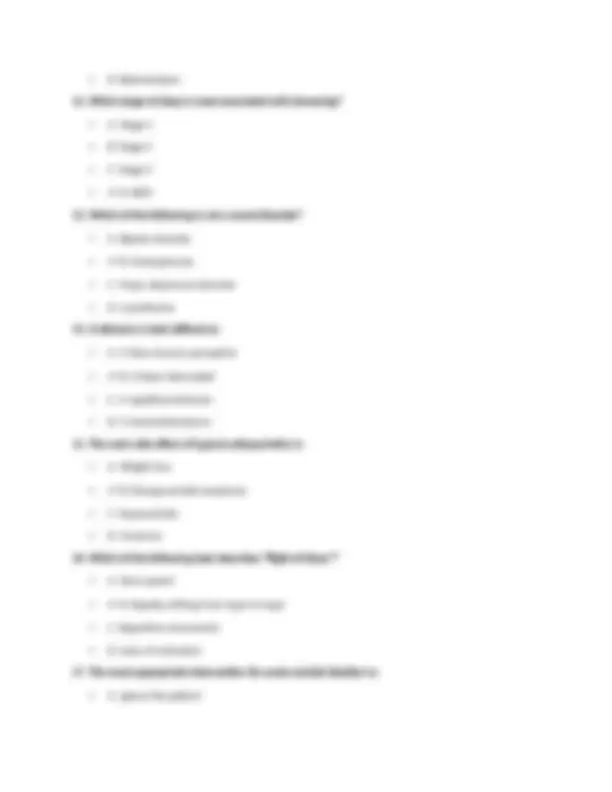
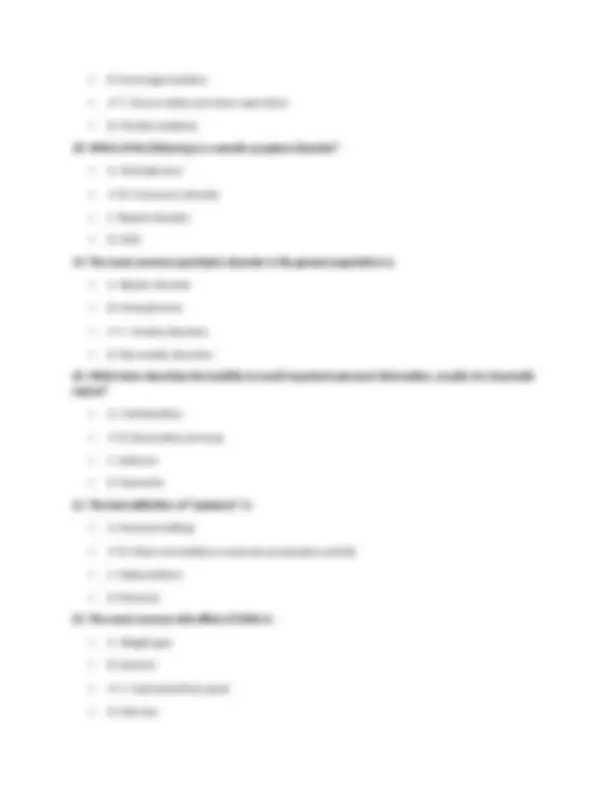
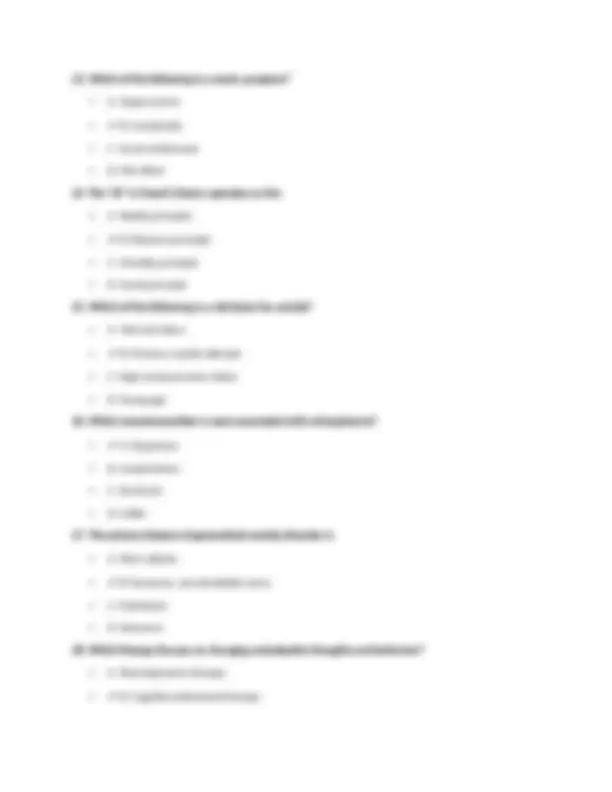
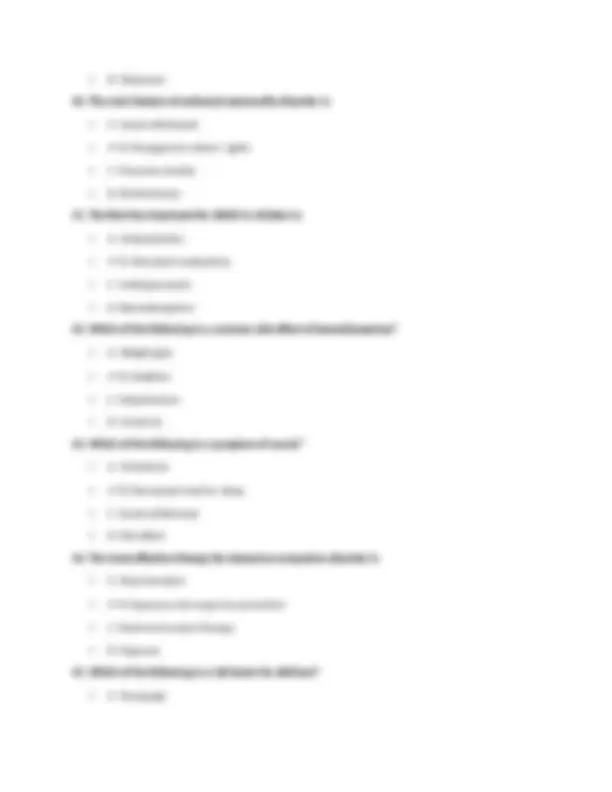
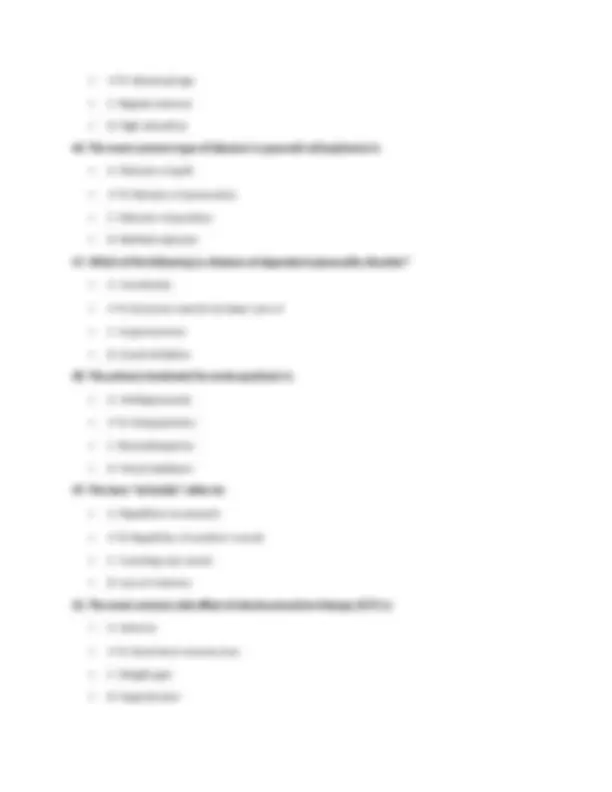



Study with the several resources on Docsity

Earn points by helping other students or get them with a premium plan


Prepare for your exams
Study with the several resources on Docsity

Earn points to download
Earn points by helping other students or get them with a premium plan
Community
Ask the community for help and clear up your study doubts
Discover the best universities in your country according to Docsity users
Free resources
Download our free guides on studying techniques, anxiety management strategies, and thesis advice from Docsity tutors
Midterm Examination: Fundamentals of Psychiatry and Behavioral Sciences. Midterm Examination: Fundamentals of Psychiatry and Behavioral Sciences.
Typology: Exams
1 / 10

This page cannot be seen from the preview
Don't miss anything!







1. Which of the following is a positive symptom of schizophrenia? A. Social withdrawal B. Flat affect ✔ C. Hallucinations D. Poor hygiene 2. The neurotransmitter most implicated in depression is: A. Dopamine ✔ B. Serotonin C. Acetylcholine D. GABA 3. Which defense mechanism involves attributing one’s own unacceptable thoughts to others? A. Rationalization ✔ B. Projection C. Sublimation D. Regression 4. A persistent, irrational fear of an object or situation is called: A. Obsession ✔ B. Phobia C. Delusion D. Compulsion 5. The Mini-Mental State Examination (MMSE) primarily assesses: A. Mood ✔ B. Cognitive function C. Motor skills D. Personality 6. Which personality disorder is characterized by instability in relationships and self-image?
A. Avoidant ✔ B. Borderline C. Schizoid D. Paranoid
7. The term “anhedonia” refers to: A. Excessive energy B. Loss of memory ✔ C. Loss of pleasure D. Fear of crowds 8. The most common hallucination in schizophrenia is: A. Visual ✔ B. Auditory C. Tactile D. Olfactory 9. The primary feature of obsessive-compulsive disorder is: A. Delusions ✔ B. Recurrent intrusive thoughts and repetitive behaviors C. Hallucinations D. Disorganized speech 10. Which of the following is a negative symptom of schizophrenia? A. Delusions B. Hallucinations ✔ C. Flat affect D. Grandiosity 11. The first-line treatment for panic disorder is: A. Antipsychotics ✔ B. SSRIs C. Lithium
B. Encourage isolation ✔ C. Ensure safety and close supervision D. Provide sedatives
18. Which of the following is a somatic symptom disorder? A. Schizophrenia ✔ B. Conversion disorder C. Bipolar disorder D. OCD 19. The most common psychiatric disorder in the general population is: A. Bipolar disorder B. Schizophrenia ✔ C. Anxiety disorders D. Personality disorders 20. Which term describes the inability to recall important personal information, usually of a traumatic nature? A. Confabulation ✔ B. Dissociative amnesia C. Delirium D. Dementia 21. The best definition of “catatonia” is: A. Excessive talking ✔ B. Motor immobility or excessive purposeless activity C. Hallucinations D. Paranoia 22. The most common side effect of SSRIs is: A. Weight gain B. Seizures ✔ C. Gastrointestinal upset D. Hair loss
23. Which of the following is a manic symptom? A. Hypersomnia ✔ B. Grandiosity C. Social withdrawal D. Flat affect 24. The “id” in Freud’s theory operates on the: A. Reality principle ✔ B. Pleasure principle C. Morality principle D. Social principle 25. Which of the following is a risk factor for suicide? A. Married status ✔ B. Previous suicide attempt C. High socioeconomic status D. Young age 26. Which neurotransmitter is most associated with schizophrenia? ✔ A. Dopamine B. Acetylcholine C. Serotonin D. GABA 27. The primary feature of generalized anxiety disorder is: A. Panic attacks ✔ B. Excessive, uncontrollable worry C. Flashbacks D. Delusions 28. Which therapy focuses on changing maladaptive thoughts and behaviors? A. Psychodynamic therapy ✔ B. Cognitive-behavioral therapy
A. Weight gain ✔ B. Tremor C. Sedation D. Hypertension
35. Which of the following is a symptom of major depressive disorder? ✔ A. Anhedonia B. Euphoria C. Grandiosity D. Flight of ideas 36. The term “neologism” refers to: A. Repetitive movements ✔ B. Inventing new words C. Slow speech D. Memory loss 37. Which of the following is a negative symptom of schizophrenia? A. Delusions ✔ B. Social withdrawal C. Hallucinations D. Disorganized speech 38. The most common cause of dementia is: A. Vascular disease ✔ B. Alzheimer’s disease C. Parkinson’s disease D. Huntington’s disease 39. Which of the following is an example of a somatic symptom? A. Hallucination ✔ B. Pain without a medical cause C. Delusion
D. Obsession
40. The main feature of antisocial personality disorder is: A. Social withdrawal ✔ B. Disregard for others’ rights C. Excessive anxiety D. Perfectionism 41. The first-line treatment for ADHD in children is: A. Antipsychotics ✔ B. Stimulant medications C. Antidepressants D. Benzodiazepines 42. Which of the following is a common side effect of benzodiazepines? A. Weight gain ✔ B. Sedation C. Hypertension D. Insomnia 43. Which of the following is a symptom of mania? A. Anhedonia ✔ B. Decreased need for sleep C. Social withdrawal D. Flat affect 44. The most effective therapy for obsessive-compulsive disorder is: A. Psychoanalysis ✔ B. Exposure and response prevention C. Electroconvulsive therapy D. Hypnosis 45. Which of the following is a risk factor for delirium? A. Young age